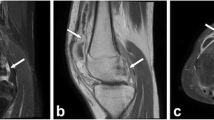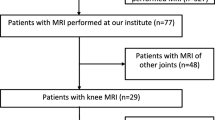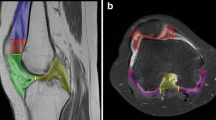Abstract
Objectives
To assess the value of magnetic resonance imaging (MRI) in discriminating between active and inactive juvenile idiopathic arthritis (JIA) patients and to compare physical examination outcomes with MRI outcomes in the assessment of disease status in JIA patients.
Methods
Consecutive JIA patients with knee involvement were prospectively studied using an open-bore MRI. Imaging findings from 146 JIA patients were analysed (59.6 % female; mean age, 12.9 years). Patients were classified as clinically active or inactive. MRI features were evaluated using the JAMRIS system, comprising validated scores for synovial hypertrophy, bone marrow oedema, cartilage lesions and bone erosions.
Results
Inter-reader reliability was good for all MRI features (intra-class correlation coefficient [ICC] = 0.87–0.94). No differences were found between the two groups regarding MRI scores of bone marrow oedema, cartilage lesions or bone erosions. Synovial hypertrophy scores differed significantly between groups (P = 0.016). Nonetheless, synovial hypertrophy was also present in 14 JIA patients (35.9 %) with clinically inactive disease. Of JIA patients considered clinically active, 48.6 % showed no signs of MRI-based synovitis.
Conclusions
MRI can discriminate between clinically active and inactive JIA patients. However, physical examination is neither very sensitive nor specific in evaluating JIA disease activity compared with MRI. Subclinical synovitis was present in >35 % of presumed clinically inactive patients.
Key points
• MRI is sensitive for evaluating juvenile idiopathic arthritis (JIA) disease activity.
• Contrast-enhanced MRI can distinguish clinically active and inactive JIA patients.
• Subclinical synovitis is present in 35.9 % of presumed clinically inactive patients.
• Physical examination is neither sensitive nor specific in evaluating JIA disease activity.





Similar content being viewed by others
References
Ravelli A, Martini A (2007) Juvenile idiopathic arthritis. Lancet 369:767–778
Gardner-Medwin JM, Killeen OG, Ryder CA, Bradshaw K, Johnson K (2006) Magnetic resonance imaging identifies features in clinically unaffected knees predicting extension of arthritis in children with monoarthritis. J Rheumatol 33:2337–2343
Johnson K (2006) Imaging of juvenile idiopathic arthritis. Pediatr Radiol 36:743–758
Brown AK, Conaghan PG, Karim Z et al (2008) An explanation for the apparent dissociation between clinical remission and continued structural deterioration in rheumatoid arthritis. Arthritis Rheum 58:2958–2967
Guzman J, Burgos-Vargas R, Duarte-Salazar C, Gomez-Mora P (1995) Reliability of the articular examination in children with juvenile rheumatoid arthritis: interobserver agreement and sources of disagreement. J Rheumatol 22:2331–2336
Malattia C, Consolaro A, Pederzoli S et al (2013) MRI versus conventional measures of disease activity and structural damage in evaluating treatment efficacy in juvenile idiopathic arthritis. Ann Rheum Dis 72:363–368
Miller E, Uleryk E, Doria AS (2009) Evidence-based outcomes of studies addressing diagnostic accuracy of MRI of juvenile idiopathic arthritis. AJR Am J Roentgenol 192:1209–1218
Doria AS, Babyn PS, Feldman B (2006) A critical appraisal of radiographic scoring systems for assessment of juvenile idiopathic arthritis. Pediatr Radiol 36:759–772
Malattia C, Damasio MB, Magnaguagno F et al (2008) Magnetic resonance imaging, ultrasonography, and conventional radiography in the assessment of bone erosions in juvenile idiopathic arthritis. Arthritis Rheum 59:1764–1772
Petty RE, Southwood TR, Manners P et al (2004) International League of Associations for Rheumatology classification of juvenile idiopathic arthritis: second revision, Edmonton, 2001. J Rheumatol 31:390–392
Wallace CA, Giannini EH, Huang B, Itert L, Ruperto N (2011) American College of Rheumatology provisional criteria for defining clinical inactive disease in select categories of juvenile idiopathic arthritis. Arthritis Care Res (Hoboken) 63:929–936
Singh G, Athreya BH, Fries JF, Goldsmith DP (1994) Measurement of health status in children with juvenile rheumatoid arthritis. Arthritis Rheum 37:1761–1769
Wulffraat N, van der Net JJ, Ruperto N et al (2001) The Dutch version of the Childhood Health Assessment Questionnaire (CHAQ) and the Child Health Questionnaire (CHQ). Clin Exp Rheumatol 19:S111–S115
Consolaro A, Ruperto N, Bazso A et al (2009) Development and validation of a composite disease activity score for juvenile idiopathic arthritis. Arthritis Rheum 61:658–666
Marshall SP, Smith MS, Weinberger E (1995) Perceived anxiety of pediatric patients to magnetic resonance. Clin Pediatr (Phila) 34:59–60
Hemke R, van Veenendaal M, Kuijpers TW, van Rossum MA, Maas M (2012) Increasing feasibility and patient comfort of MRI in children with juvenile idiopathic arthritis. Pediatr Radiol 42:440–448
Hemke R, Kuijpers TW, van den Berg JM et al (2013) The diagnostic accuracy of unenhanced MRI in the assessment of joint abnormalities in juvenile idiopathic arthritis. Eur Radiol 23:1998–2004
Østergaard M, Klarlund M (2001) Importance of timing of post-contrast MRI in rheumatoid arthritis: what happens during the first 60 minutes after IV gadolinium-DTPA? Ann Rheum Dis 60:1050–1054
Hemke R, van Rossum MA, van Veenendaal M et al (2013) Reliability and responsiveness of the Juvenile Arthritis MRI Scoring (JAMRIS) system for the knee. Eur Radiol 23:1075–1083
Rooney ME, McAllister C, Burns JF (2009) Ankle disease in juvenile idiopathic arthritis: ultrasound findings in clinically swollen ankles. J Rheumatol 36:1725–1729
Nistala K, Babar J, Johnson K et al (2007) Clinical assessment and core outcome variables are poor predictors of hip arthritis diagnosed by MRI in juvenile idiopathic arthritis. Rheumatology (Oxford) 46:699–702
Haslam KE, McCann LJ, Wyatt S, Wakefield RJ (2010) The detection of subclinical synovitis by ultrasound in oligoarticular juvenile idiopathic arthritis: a pilot study. Rheumatology (Oxford) 49:123–127
Janow GL, Panghaal V, Trinh A, Badger D, Levin TL, Ilowite NT (2011) Detection of active disease in juvenile idiopathic arthritis: sensitivity and specificity of the physical examination vs ultrasound. J Rheumatol 38:2671–2674
Magni-Manzoni S, Epis O, Ravelli A et al (2009) Comparison of clinical versus ultrasound-determined synovitis in juvenile idiopathic arthritis. Arthritis Rheum 61:1497–1504
Rebollo-Polo M, Koujok K, Weisser C, Jurencak R, Bruns A, Roth J (2011) Ultrasound findings on patients with juvenile idiopathic arthritis in clinical remission. Arthritis Care Res (Hoboken) 63:1013–1019
Brown A, Hirsch R, Laor T et al (2012) Patients with juvenile idiopathic arthritis in clinical remission have evidence of persistent inflammation as revealed by 3T MRI. Arthritis Care Res (Hoboken) 64:1846–1854
Magni-Manzoni S, Pistorio A, Labo E et al (2008) A longitudinal analysis of physical functional disability over the course of juvenile idiopathic arthritis. Ann Rheum Dis 67:1159–1164
Jans LB, Jaremko JL, Ditchfield M, Verstraete KL (2011) Evolution of femoral condylar ossification at MR imaging: frequency and patient age distribution. Radiology 258:880–888
Müller LS, Avenarius D, Damasio B et al (2011) The paediatric wrist revisited: redefining MR findings in healthy children. Ann Rheum Dis 70:605–610
Acknowledgments
This work was supported by a research grant received from the Dutch Arthritis Association (Reumafonds, Amsterdam, The Netherlands). The Dutch Arthritis Association was not involved in designing and conducting this study, did not have access to the data and was not involved in data analysis or preparation of this manuscript.
Author information
Authors and Affiliations
Corresponding author
Rights and permissions
About this article
Cite this article
Hemke, R., Maas, M., van Veenendaal, M. et al. Contrast-enhanced MRI compared with the physical examination in the evaluation of disease activity in juvenile idiopathic arthritis. Eur Radiol 24, 327–334 (2014). https://doi.org/10.1007/s00330-013-3036-2
Received:
Revised:
Accepted:
Published:
Issue Date:
DOI: https://doi.org/10.1007/s00330-013-3036-2




